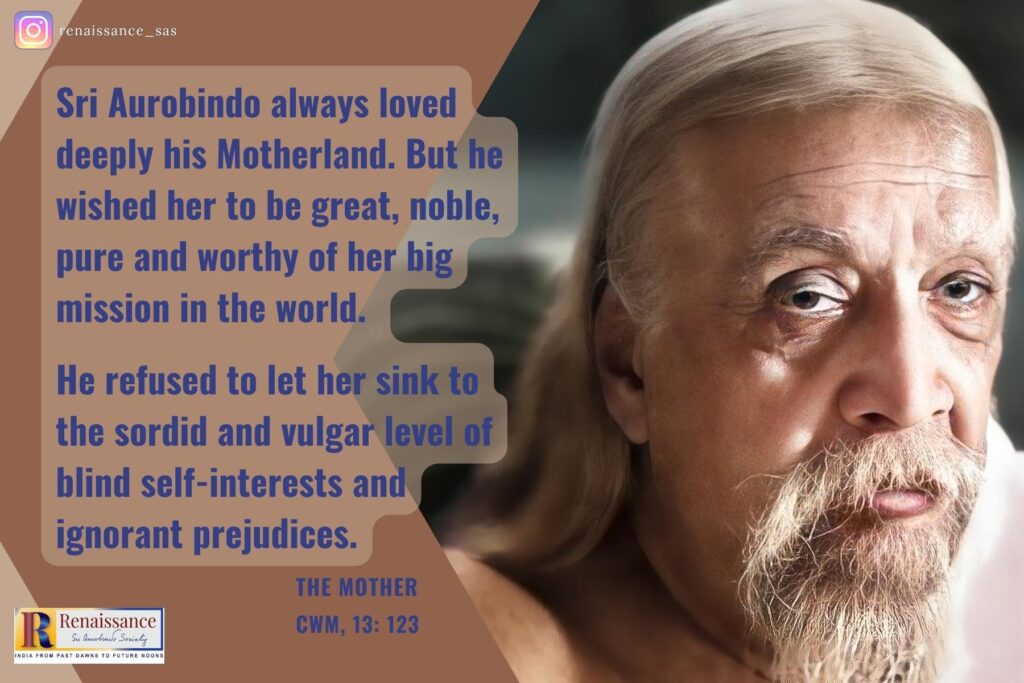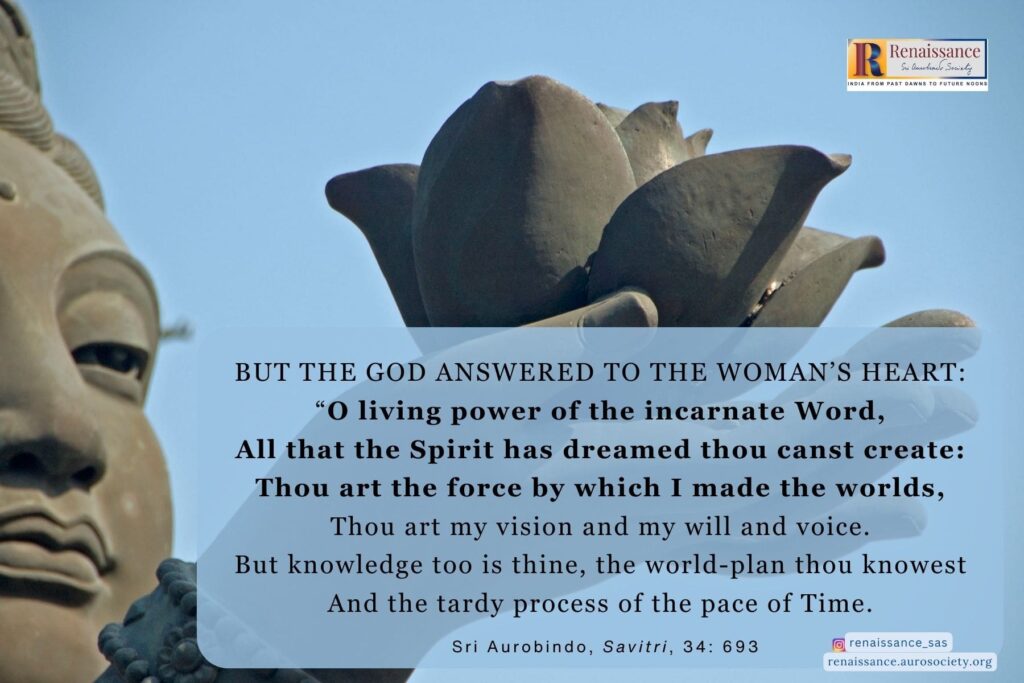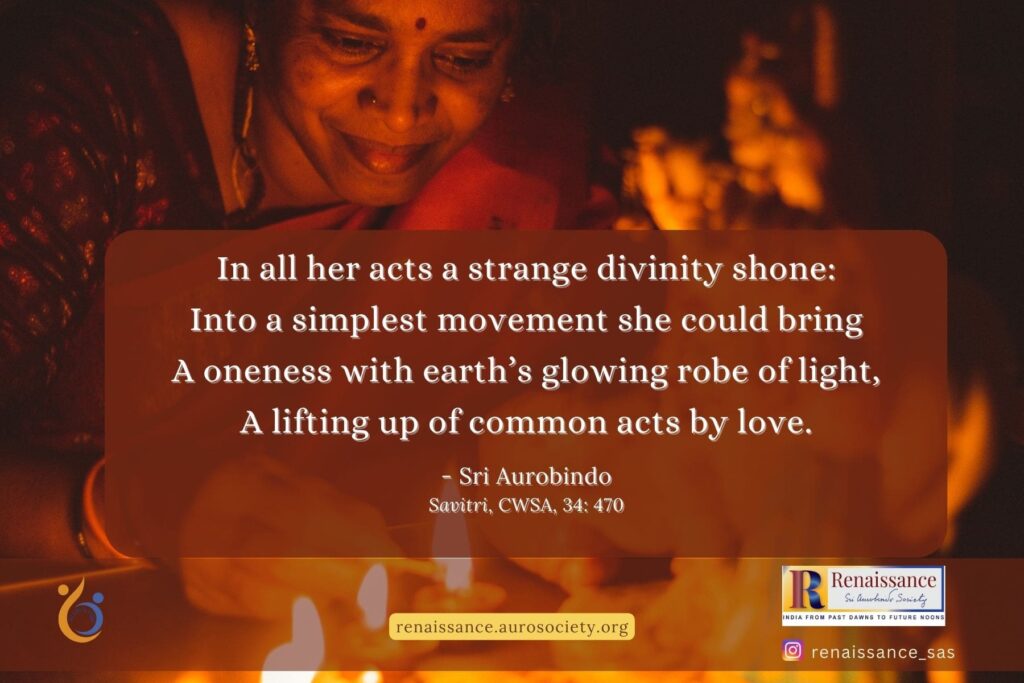Editor’s Note: Dr. Beloo Mehra weaves together some spiritual insights on love and human relationships from various works of Sri Aurobindo and the Mother along with examples from Indian literary tradition. A longer version of this article was first published in Sraddha, Vol. 11 (4), April 2020, pp. 82-99. We republish it here in three parts, with a few minor formatting changes necessary for digital presentation.
In this first part, the focus is on love as a universal force. Love is an act of supreme self-giving of the Divine to awaken in humans the yearning to unite with their true source. This part also highlights that behind all movements of human love and relations, the deeper seeking is the seeking for oneness, beauty and delight.
🌸🌸🌸
Introduction
Love and relationships are the root of all human life as lived in our familial and societal contexts. But ordinarily, most people do not take the trouble to examine and understand the nature of these two things. Life situations generally have a way of making people experience several different aspects of human love and relationships. And in the process one goes through a variety of emotions, ranging all the way from pleasure to pain, from passion to indifference, from happiness to sadness, from calmness to rage, and so on. Such ups and downs cause much turmoil in people’s lives – outer and inner, and also lead to strained and troubled relationships.
A deeper awareness of the nature of human love and its expression through different relationships can prepare us to deal more effectively with inevitably shifting life situations.
By becoming conscious observers of the various emotions – not all of which may necessarily be grounded in love – that fill up the space of our human relationships we can also avoid going through unnecessary turmoil in our outer lives and needless disturbances in our inner lives.
Generally in present times, much of what young people learn about love and relationships is through popular culture – fiction, films, television and social media. Most of the times such unfiltered exposure to a variety of influences, most of which are not necessarily educative but rather meant to stimulate the lower nature of the individual – instincts, passion, and sensations, can end up creating more confusing and muddled understanding.
We must examine the nature of human love and relationships using a deeper psycho-spiritual view.
This has been given to us by the great yogis, sages and seers who have not only explored the depths of human nature but have also raised themselves to the highest heights of consciousness. No human experience is insignificant in their wider view of life and existence. And that’s why we are able to find relevant insights on almost all aspects of life in their writings and teachings. Through this article I hope to highlight some of these insights as applicable to the topics of love and human relationships.
Love, a Universal Force
What is the essential nature of love? Is there more than one kind of love? Is love a personal thing or something more universal in nature? What does it mean when people use the expression ‘falling in love’?
The Mother describes love as one of the great universal forces. She explains:
…[love] exists by itself and its movement is free and independent of the objects in which and through which it manifests. It manifests wherever it finds a possibility for manifestation, wherever there is receptivity, wherever there is some opening for it. What you call love and think of as a personal or individual thing is only your capacity to receive and manifest this universal force.
But because it is universal, it is not therefore an unconscious force; it is a supremely conscious Power. Consciously it seeks for its manifestation and realisation upon earth; consciously it chooses its instruments, awakens to its vibrations those who are capable of an answer, endeavours to realise in them that which is its eternal aim, and when the instrument is not fit, drops it and turns to look for others.
Men think that they have suddenly fallen in love; they see their love come and grow and then it fades – or, it may be, endures a little longer in some who are more specially fitted for its more lasting movement. But their sense in this of a personal experience all their own was an illusion. It was a wave from the everlasting sea of universal love.”
(CWM, Vol. 3, p. 69)
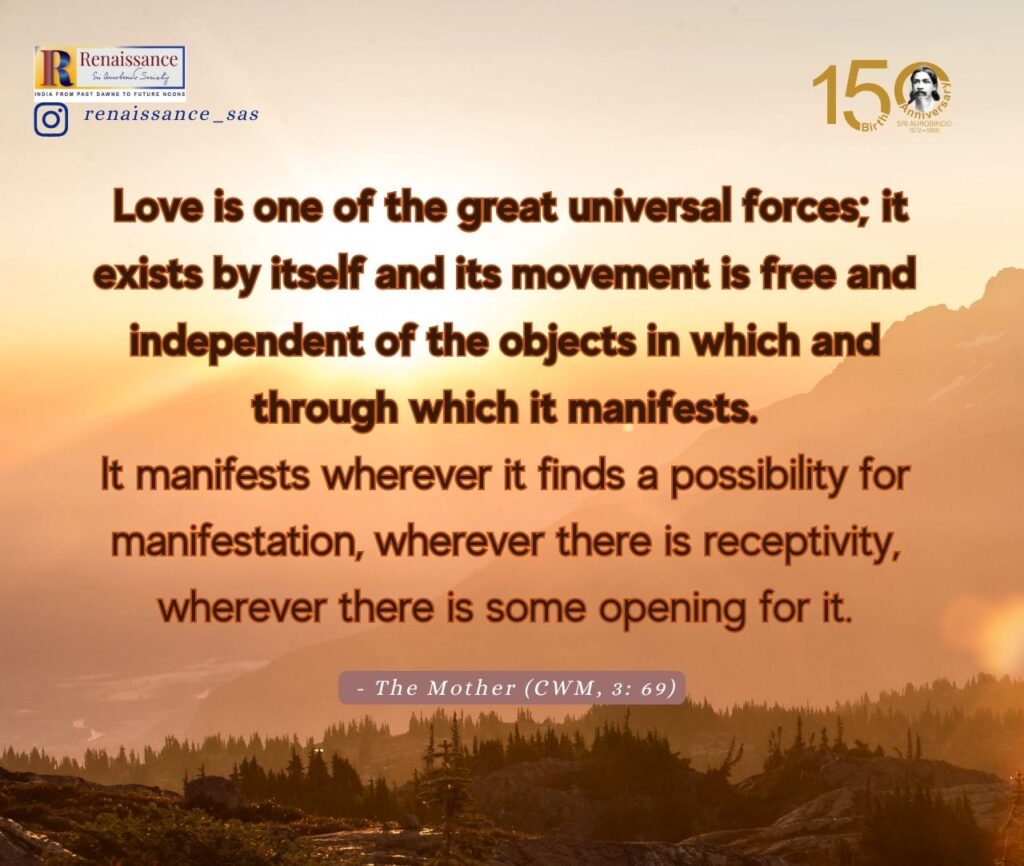
It is indeed quite liberating when we can see that love that we experience as an individual comes to us as a wave from an everlasting sea of universal love.
A question then naturally arises – what does it mean to be receptive and open to the force of love? A related question is – how should an individual become a fit instrument for love to manifest through him or her?
Love is complete self-giving
Our sages have explained that the entire universe, this manifestation, is essentially an act of Love – Love of the Divine, the Perfect Consciousness.
The manifestation of the love of the Divine in the world is an act of supreme self-giving. But why does this act doesn’t seem like love to our ignorant minds?
Because such an act of supreme self-giving does not clothe itself in a superficial sentiment, it makes no demand in exchange for what it has done, no show of its sacrifice, explains the Mother. And that truly is the what love is about – complete self-giving.
The love of the Supreme for its creation is a movement to help awaken in the world a longing to get back to its essential divinity.
In human terms, it means that love is a force that awakens in us a yearning to get to our true source, that deep oneness within. This for a long, long time is expressed through loving another human being. No matter how distorted or deformed human love is due to human egoism and the imperfections of the human nature, at its deepest depth lies the longing for uniting with the Divine.
Read:
The Mother on Love Divine and Human
What does love seek?
According to Sri Aurobindo, love seeks for two things — eternity and intensity.
He adds that this seeking for eternity and intensity is instinctive and self-born in the relation of the Lover and Beloved (CWSA, Vol. 24, p. 569). This relation of the yearning of the human soul for the Supreme Beloved is the basis of the Vaishnava religion.
We see such seeking of love also manifesting in the human lovers. When one first falls in love with another, that love is highly intense at the beginning. And of course, never for a moment does the person think that this love will not last forever. The common phrase “happily ever after” is reflective of this seeking for eternity and intensity.
We find one beautiful example of this in the Ramayana.
In Aranya Kanda Rishi Valmiki describes Rama’s lament for Sita after she is kidnapped.
As Rama was returning (to the hermitage), his left eye throbbed repeatedly and he stumbled and his body trembled.
((Translation by Prof. P. Geervani & Prof. K. Kamala, 3.60.1-38)
As inauspicious omens appeared again and again, doubting if all is well with Sita, he said to himself, Can Sita be safe?
Anxious to see Sita, he hastened to the hermitage and finding it empty, became restless.
Rama, the delight of the Raghu dynasty, hurtled in, turning round, throwing his hands to and fro, casting his looks all around the cottage where she used to move. The cottage, devoid of Sita looked like a lotus pond, the beauty of its lotuses destroyed by winter.
The trees with flowers withered, the animals and birds turned pale looked as if they were weeping. Bereft of their beauty they wore a ruinous look. The sylvan deities had left. The deerskin and kusa grass were strewn here and there, the grass cushions and straw mats lay scattered. Seeing his cottage so desolate Rama wept again and again.
‘Timid Sita might have been abducted or dead or crushed or eaten up by demons. Or, she may be hiding for protection in the forest’
‘Maybe she has gone to pluck flowers or fruits. Or to the lotus pond or river to fetch water.’
He ransacked the forest, yet did not find his beloved. He appeared like a mad man, his eyes turned red with tears of sorrow.
Running from tree to tree, hill to hill, and river to river and weeping, Rama was immersed in a sea of sorrow.
O Kadamba tree, tell me if you have seen my beloved with a fair face and with love for kadamba flowers.
O Bilva tree, tell me if you have seen a lady delicate like your tender leaf, dressed in yellow silk, a lady whose breasts are round like Bilva fruits.
O Arjuna tree, tell me if you know a timid lady, daughter of Janaka and my beloved, fond of Arjuna tree. Is the living or not?
This Kakubha tree rich with tender leaves and flowers (perhaps)knows Maithili whose thighs are beautiful like the trunk of the Kakubha tree.
This great Tilaka tree round which bees bumble surely knows the lady who loves to put tilaka marks on the forehead.
O Ashoka tree, dispeller of sorrow, by quickly showing me my darling make me ashoka (free from sorrow) as I am grief stricken at heart.
O Palmyra tree be kind to me and tell me if you have seen my beautiful beloved who has breasts like ripe palmyra fruit?
O Jambu tree, do not hesitate to tell me if you know Sita whose body shines lovely like gold.
O Karnikara tree with flowers in full bloom, tell me if you have seen my faithful beloved who is fond of karnikara flowers.
Renowned Rama, like a madman confused, approached the Mango, Kadamba, Sal and Jackfruit, Dhava, Champak, Ketaki trees and Pomegranate, Jasmine and Madhavi creepers, in order to make similar queries.
Or, O deer do you know about Maithili who has the eyes of a fawn? My beloved who has the restless eyes of a doe may be found in their company.
O elephant tell me if you have seen her whose thighs are like the trunk of an elephant. O best of elephants, tell me if you know her.
O tiger tell me freely and fearlessly if you have seen my beloved princess from Mithila with a face like the moon.
O lotus eyed darling, why are you running away? I have already seen you. Why are you hiding behind trees and not replying to me?
O my beautiful beloved, stay, stay Have you no compassion for me? You are so fond of fun. Why do you avoid me?
O lady of lovely complexion, I can see your yellow silk (flying), while you are running away. If you have love for me, stay on.
O lady with a sweet smile I have never hurt you. When I am in difficulty it does not behove you to ignore me.
It is clear that separated from me, the body of my young beloved is torn off and eaten away by carnivorous demons.
Her beautiful face with her sparkling teeth and lips, well-shaped nose, shining earrings has been like the full moon, eclipsed and rendered pale.
That delicate, beautiful neck of my beloved having the complexion of a champak flower and adorned with necklaces was perhaps eaten up.
Her arms, delicate like tender leaves, their tips (fingers) quivering, adorned with armlets and bracelets have surely been eaten away.
The young lady having many relations, forsaken by me, has been (perhaps) picked up by a demon for food and later abandoned half-eaten.
O long-armed Lakshmana, are you able to see my beloved anywhere? O noble lady, O darling, where have you gone? O Sita, Sita!
Rama ran from forest to forest, now jumping, now taking strong strides, but all the time weeping, a madman busy in search of his beloved.
He rushed through forests, rivers, hills and mountain streams and through dense jungles with an unstable mind.
Rama went about the vast forest searching for the princess from Mithila all over not giving up hope of finding her. He continued to make great efforts for searching his beloved.
Thus ends the sixtieth sarga (canto) of Aranyakanda of the Ramayana. Such sorrowful lament continues in the next sarga in the poem.
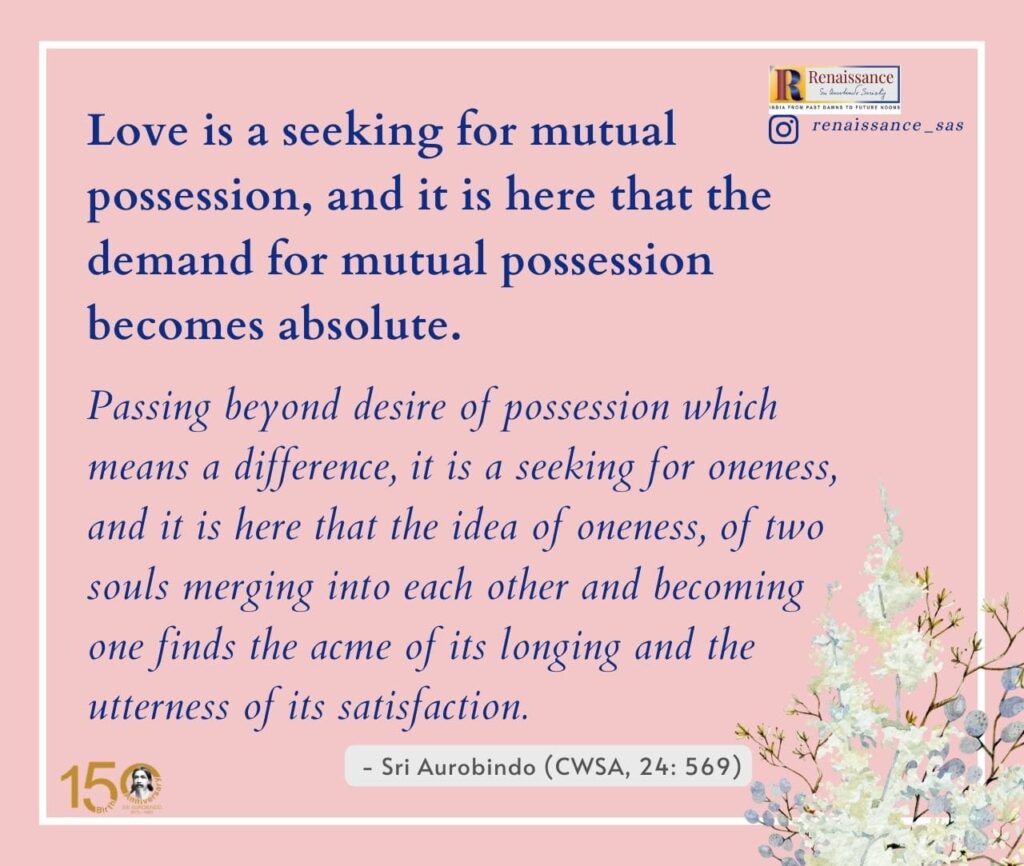
Love is also a seeking for mutual possession.
In a relation of the lover and beloved, this demand for mutual possession becomes absolute. However, the desire of possession still assumes a difference between the two – lover and beloved. The deeper seeking is that of a oneness, “of two souls merging into each other and becoming one” (Sri Aurobindo, CWSA, Vol. 24, p. 569). This is what will ultimately satisfy the lover.
We find great examples of this intense yearning in love poetry from various cultures. Kālidāsa, the great Sanskrit master-poet of sensuous beauty dealt with human emotions in a very delicate way. In Act III of Vikaramorvasie, we find some beautiful description of the deep yearning of a lover. He is unable to sleep because of not being with his beloved. He is also unable to paint a picture of her beloved because he is worried that his tears may spoil her sweet face drawn on paper.
How can I, with this rankling wound of love,
(Translation by Sri Aurobindo, CWSA, Vol. 5, p. 151)
Call to me sleep who marries men with dreams?
And if I paint the sweetness of her face,
Will not the tears, before it is half done,
Blurring my gaze with mist, blot the dear vision?
Love is also a seeker for beauty and delight.
This yearning is eternally satisfied in the vision and the touch and the joy of the beloved. A lover finds the highest possible ecstasy in every fiber of the being only when he or she is with his or her beloved.
We find a good example of love’s yearning for beauty and delight in Kālidāsa’s Meghdūtam. The story is of a husband banished for a year from his home and wife.
The husband sends “his imagination travelling on the wings of the northward-bound cloud over the sacred places, the great cities and rivers of India to the snowbound Himalaya and the homes of the Gods. There his mind sees his wife, breathes to her all its sorrow and longing and prays for an answering message. The love described may not be on the highest altitudes, but it is utterly real and human, full of enduring warmth, tenderness & passion, of strife and joy, tears and kisses, the daily food of love” (Sri Aurobindo, CWSA, Vol. 1, p. 238).
Sri Aurobindo reminds that this relation between a lover and the beloved demands the most.
And even when it reaches the greatest intensities it is still the least satisfied. This is because only in the Divine can love – any love – find its real and its utter satisfaction.
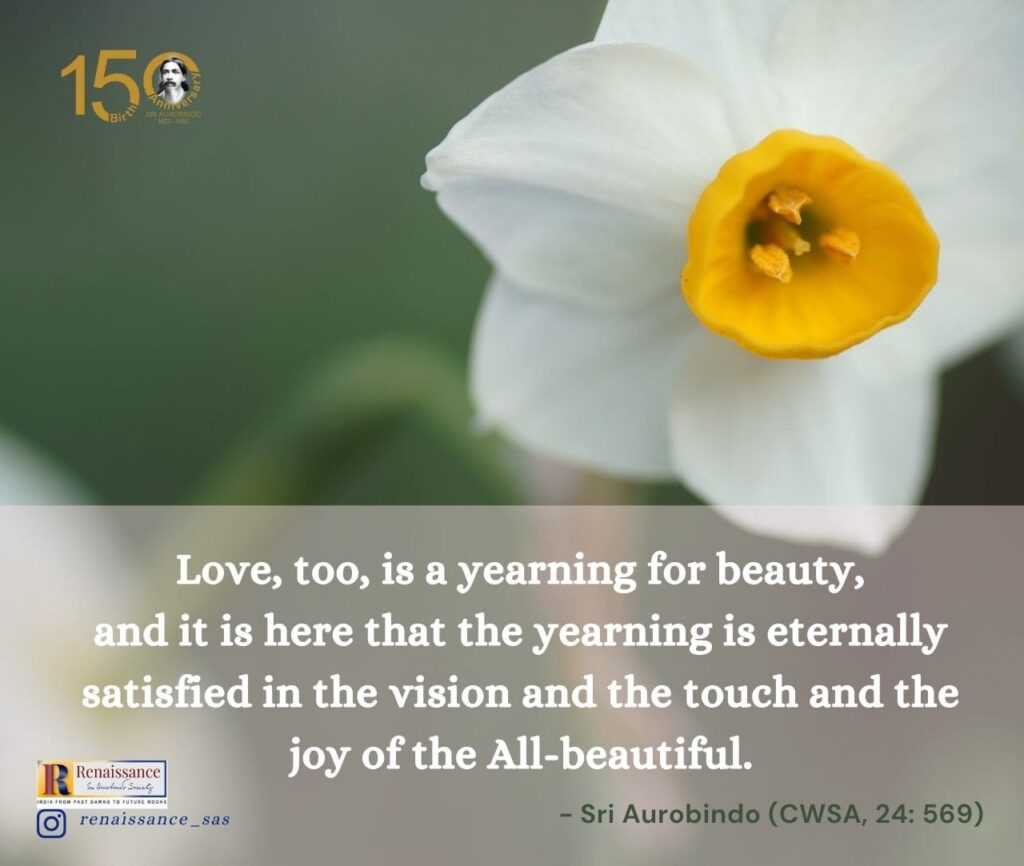
Love, Sacrifice and Ego
Ego is a formation of Prakriti and gives an individual a sense of separate existence. But in reality, ego is not and can neither be independent nor separate. It cannot live to itself even if it were able to. Because in truth all beings are linked together by a secret Oneness. An individual’s growth happens only when he or she moves away from the separate existence and interacts, relates, cooperates, and unites with other beings. This is where the play of ego comes in.
A relation of love between two human beings demands, rather necessitates a spirit of self-giving and sacrifice. But, most often, this sacrifice is done unconsciously. It is done egoistically and without knowledge or acceptance of the true meaning of the self-giving. Majority of people experience love in this way – limited and tortured by the smallness and suffering of the ego.
Yet all around we see the strong need human beings have for love.
There is an irresistible push and seeking for it. Behind all these movements of human longing and seeking all these movements acts the force of Divine love. This divine force touches millions of instruments, trying always, always failing. But this constant touch prepares these instruments till one day the capacity of true self-giving, the capacity of true love awakes in them.
“Not for the sake of the wife,” says Yajnavalkya in the Upanishad, “but for the sake of the Self is the wife dear to us.” This in the lower sense of the individual self is the hard fact behind the coloured and passionate professions of egoistic love; but in a higher sense it is the inner significance of that same love too which is not egoistic but divine.
All true love and all sacrifice are in their essence Nature’s contradiction of the primary egoism and its separative error; it is her attempt to turn from a necessary first fragmentation towards a recovered oneness.…
The law of sacrifice travels in Nature towards its culmination in this complete and unreserved self-giving; it awakens the consciousness of one common self in the giver and the object of the sacrifice. This culmination of sacrifice is the height even of human love and devotion when it tries to become divine; for there too the highest peak of love points into a heaven of complete mutual self-giving, its summit is the rapturous fusing of two souls into one.
(Sri Aurobindo, Vol. 23, pp. 107-108)
🌸🌸🌸🌸
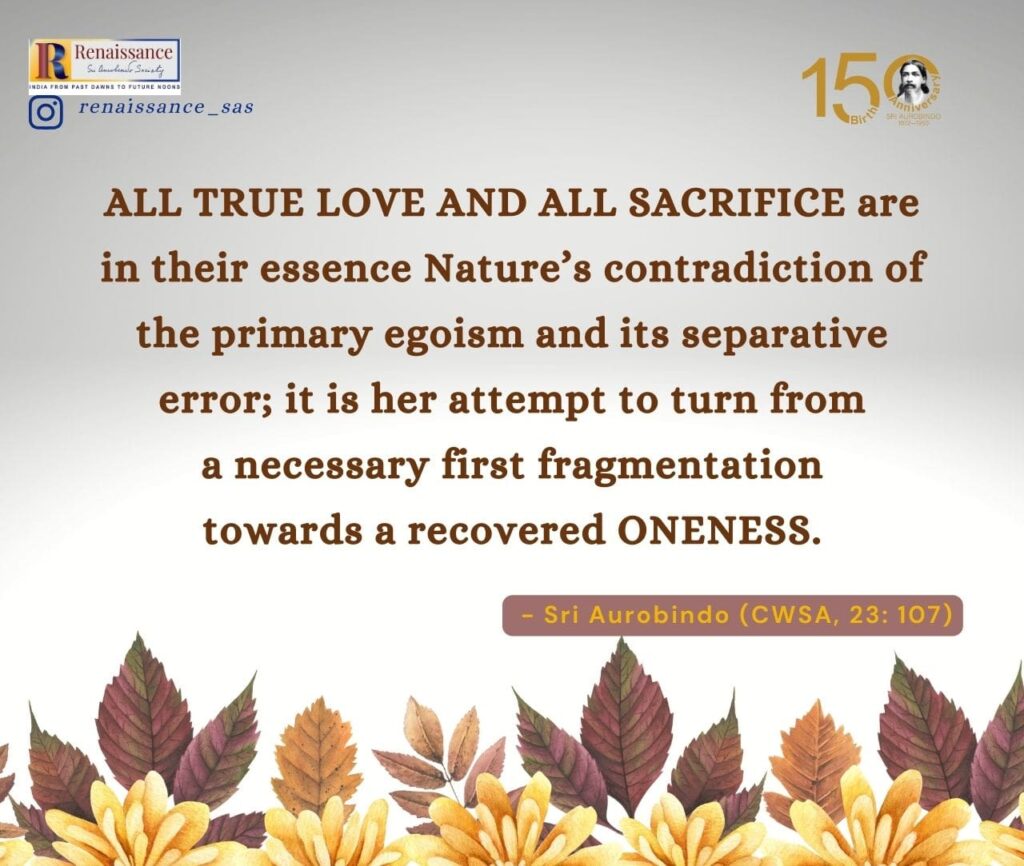
Continue reading PART 2
~ Design: Raamkumar

